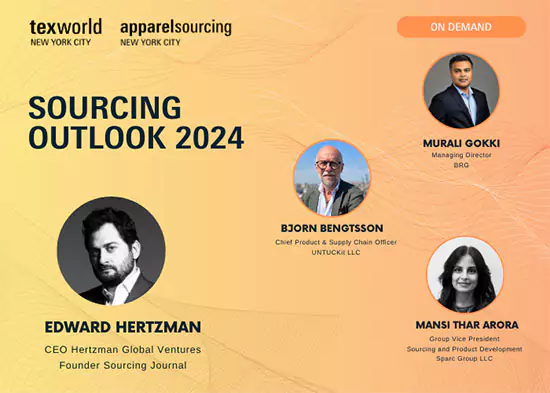In the era of voluntary sustainability action, fashion firms have leaned into a slew of certifications to help them regulate their supply chains and communicate those efforts to stakeholders and consumers.
Those symbols on hangtags served to substantiate marketing claims around ESG actions, differentiating companies and products from the mainstream—and acting as a beacon for shoppers drowning in a sea of greenwashing. But the certification system isn’t perfect and with the promise of environmental and social regulations on the horizon, it’s possible that their role in the march toward a more responsible industry will change.
“There are a lot of credible certifications out there, but brands and retailers must ensure that they choose carefully and adhere to their guidelines to ensure that they are used correctly,” Jocelyn Wilkinson, partner and associate director at BCG consulting, told Texworld. When this is the case, she said, certifications are an effective tool toward verifying sustainability claims.
But when not used correctly, certifications can sometimes facilitate greenwashing.
In a recent article defining the term, Fashion United pointed to the ways in which the very tools designed to bring clarity to the marketplace actually exacerbate the problem. “Some products may have labels, symbols or certifications that suggest they are environmentally friendly, when in reality they only meet minimum standards or relate to another aspect of the product, for example,” the article stated. Think, jeans that contain a scant amount of organic cotton proudly displaying a symbol that implies the entire product is organic.
“[Sustainability] certifications in general are a good thing. They’re important because we do need some verification… The challenge is that there are a lot of different sustainability certifications, and we don’t know what to look for or trust. Very few are regulated [by the government], and many are voluntary,” Sandra Goldmark, director of sustainability at Barnard College and senior assistant dean for interdisciplinary engagement at the Columbia Climate School, told Forbes.
With regulations on the horizon, the formerly voluntary actions will become mandatory, a fact that could change apparel’s relationship to certifying bodies, which currently have little to no authority to hold companies accountable for sticking to their commitments.
“The regulatory landscape is changing so much as we speak so it’s kind of hard to say exactly what’s going to happen when it comes to certifications,” Michelle Mendlewicz, senior sustainability strategist at sustainability consultancy Quantis, told Texworld. “But I think what we can say is that transparency and accountability are really the name of the game here. Everyone wants more transparency and accountability so as long as we’re all working towards the same goals, I think there is a place where both regulations and certifications can help you move in the right direction.”
In some cases, she said, certifications may become redundant, but in others, they could continue to be a valuable resource, as the industry attempts to comply with the data and traceability mandates called for in legislation like the Corporate Sustainability Reporting Directive and the New York Fashion Act.
When it comes to vetting certifications, Forbes outlines three key ways to evaluate a certification program: look for a well-defined application process, clearly established guidelines and a positive reputation.
But even before identifying a certification, Mendlewicz said brands need to take a thoughtful approach to their sustainability efforts. “A lot of the sustainability programs that companies have in place are super confusing and not setting them up for success,” she said, explaining that in many cases, that’s the reason companies aren’t seeing results. “You need to have a robust and well-thought out strategy in place where you think, ‘what are the priorities for my business?’ Once you have those priorities mapped out, you can think about what you have to do to comply with regulations. And then you can ask, ‘what are the certification options that are going to help drive these priorities forward and meet regulatory expectations?’”
Ultimately, it may take more than one, Wilkinson said.
“There is no one-size-fits-all approach,” she said. “Instead, I would always advise brands to take a ‘portfolio approach’ in order to test and learn from a number of methods in order to achieve their goals.”

Textile Talks On Demand: Sourcing Outlook 2024
In a recent Textile Talks panel, “Sourcing Outlook 2024,” Bjorn Bengtsson, chief product and supply chain officer, Untuckit; Masni Thar Arora, group vice president sourcing and production development, Sparc Group; and Murali Gokki, managing director of BRG, discuss how the changing landscape for diversification, supplier-brand relationships and sustainability.
The discussion is now available on demand. Below are a few key takeaways:
Gokki on diversification out of China: “What is left in China is hard to replicate in other countries, which is a supplier base that is extremely flexible, agile and able to cater to the specific short and specialty runs the industry needs, and unfortunately the other competing countries are not there yet. But despite this shift in finished goods, what you’re finding is that China still dominates the raw material base [adding additional lead times].”
Arora on the importance of buyer-supplier relationships: “We’ve been able to convert to chasing 30 percent of the goods now. We are not committing to 100 percent. We want to read and react, and most of our vendors have been able to adapt to that. That’s the need and demand to keep up with the volatile environment that we are in.”
Bengtsson on the need for sustainability regulation: “We talk about profit, planet and people but any company in the world will put profit first…. Consequently, we need laws to even out the playing field. What we need is really to put pressure on Congress to institute laws and regulation. The EU has a lot of initiatives going on right now… and we need the same in the United States.”
Watch the discussion on demand here to learn:
- what’s keeping supply chain executives awake at night
- the financial challenges suppliers are facing in terms of financing and labor costs
- how to mitigate risk through collaboration
- why regulation is the only true catalyst for sustainability momentum
- what the shift away from opportunistic sourcing means for the industry
- why agreeing to work toward carbon neutrality isn’t enough

Webinar: Managing Supply Chain Uncertainty
Join Texworld for a supply chain webinar on April 25 at 11:00 AM EST designed specifically for supply chain executives, apparel retailers, and industry stakeholders.
The “Managing Uncertainty: Geopolitical Risks & Supply Chain Regulations” webinar will bring together top thought leaders to discuss wages and currency fluctuations, UFLPA impacts, future-proofing business in the time of regulation, building accountability into your supply chain and the political implications of the 2024 U.S. presidential election on everything from trade deals to de minimis.
Speakers will include:
- Nate Herman, Senior Vice President, Policy, trade group American Apparel & Footwear Association
- Ethan Woolley, Strategic Growth Executive at risk assessment firm Kharon
- Munir Mashooqullah, Founder and Custodian, supply chain management firm M5 Groupe
- John Foote, Partner/Head of Customs Practice at law firm Kelley Drye & Warren, LLP
- Edward Hertzman, founder of Hertzman Global and Sourcing Journal (moderator)
*You must register for the show to attend the live webinar.
Register today to gain valuable insights into managing disruption and uncertainty throughout 2024.

Join Texworld in NYC and LA this Summer
Registration is now open for the Texworld and Apparel Sourcing shows in July and August.
Both East and West Coast events bring together textile innovators, industry leaders, and fashion professionals to explore the latest trends, connect with suppliers, and discover new opportunities. With a diverse array of product categories across the fashion, apparel, home, and print design industries and exhibitors representing global textile markets, the shows offer unparalleled networking and educational experiences for attendees.
Texworld and Apparel Sourcing New York City, Home Textiles Sourcing, Printsource
July 16-18, 2024 – Javits Center, New York City
Texworld and Apparel Sourcing Los Angeles, Printsource
August 13-14, 2024, California Market Center, Los Angeles
What We’re Reading
Apparel shoppers deprioritize sustainability, and ethics to save money
For years, studies have shown that consumers care about the environment—though buying decisions haven’t always backed that up. A new survey from GlobalData, conducted across the US, China and parts of Europe, shows that shoppers value sustainability “far less” than price and other factors. Of all the countries polled, U.S. shoppers cared about environmental factors the least at just 37.7 percent of respondents compared to 53.5 percent in Spain. Read the article in Just Style to learn how shoppers think about sustainability and why it’s not a bigger factor in decision making.
Corn to Couture? Lycra and Qore Team On Bio-Derived Spandex
Material innovation is a major focus as the industry searches for ways to reduce its reliance on virgin raw materials. Sourcing Journal reports Lycra Company has teamed with Qore to create a bio-based spandex, which will go into production by the beginning of next year. The innovation is derived from a renewable fiber made with Qira, a next-generation butanediol (BDO) created from dent corn feedstock. Read the article to learn the impact scaling this new fiber will have on Lycra’s business and carbon footprint.
For a Price, Aspiring Designers Can Tap Shein’s Fast Fashion Supply Chain
If you can’t beat’em, join’em. That may be the case with fast fashion giant Shein. Inc reports the company will offer its production and supply chain system as a software as a service. The offering could allow access to Shein’s reported 6,000-strong production base and enable brands to effectively execute on their read and react and chase models. Read the article to learn about more of the benefits—as well as the downsides—to partnering with Shein.



















